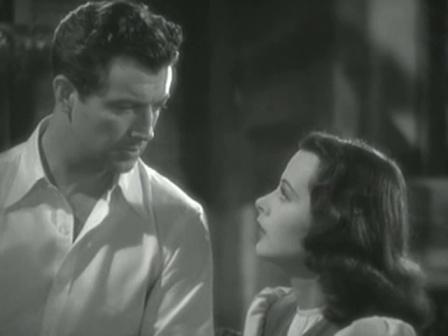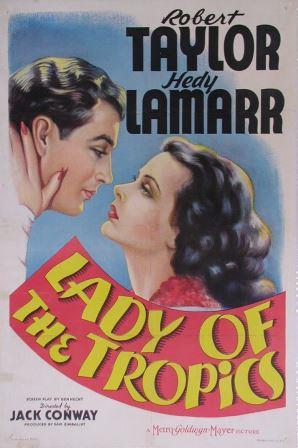Hedy Lamarr set the world aflame with her beauty in Algiers! Now you see her in the arms of a dashing Bob Taylor!
Second time’s the charm, right?
Or is that supposed to be the third time?
In any case, after Hedy Lamarr’s American debut in Algiers, MGM was eager to get her into another vehicle. Though much of her third film which eventually became 1940’s I Take This Woman was shot earlier, 1939’s Lady of the Tropics was released first, making it her second official American release.
Lady of the Tropics begins a trend which would plague Lamarr during her time at MGM. Though opinions differ as to the reason, Lamarr’s star never reached the apex which all thought she was destined for. Perhaps the reason lies in her somewhat limited range or MGM never really knowing what roles to use her effectively in.
As in most of her MGM films, Lamarr is paired with one from MGM’s cavalcade of stars; in this case it is Robert Taylor. Coming from an eighteenth century work which had previously been filmed- and had two operas written based on it as well, Lady of the Tropics tells the story of a mixed race woman (Lamar as Manon DeVargnes) who falls in love with American playboy Bill (Taylor).
Though never explicitly noted, it becomes clear that given her situation Manon is deeply involved in a relationship with Pierre Delaroch. In return for her company he has her set up in a hotel and stocked with fine gowns and baubles. Pierre’s asked for her hand several times and finally under pressure she lies to him and agrees to marry him.
 What she doesn’t share is that when she met Bill the two quickly fell in love and were married, with Manon dreaming of leaving French Indochina for Europe or the United States. Scorned and humiliated, Pierre blocks the granting of her passport and withdraws his support, leaving the newlyweds trapped in their hotel room.
What she doesn’t share is that when she met Bill the two quickly fell in love and were married, with Manon dreaming of leaving French Indochina for Europe or the United States. Scorned and humiliated, Pierre blocks the granting of her passport and withdraws his support, leaving the newlyweds trapped in their hotel room.
Finally money begins to run out and Manon and Bill are forced to move out of the hotel and into a shabbier (but still remarkably comfortable) set of rooms on the other side of town. Bill, who refuses to leave his wife, can’t find work and it is looking like they will have to move yet again.
Becoming desperate herself, Manon secretly approaches Pierre and brokers a deal. In exchange for resuming their relationship, Pierre- who owns a rubber plantation- will get Bill a job up river at the plantation and also have the restrictions on Manon’s passport lifted. Not only does this placate Manon, but it also cleverly gets Bill miles away so that he and Manon can publicly be together.
When Bill returns during a break he immediately learns what’s been going on and grabs a gun, threatening to kill Pierre. When he gets to Pierre’s palatial estate he learns that Pierre has already been shot and killed by Manon.
 He rushes back to his apartment and finds Manon sitting and staring dreamily out the window. Inexplicably it takes Bill several minutes to realize that she’s shot herself (presumably in the stomach from how it plays).
He rushes back to his apartment and finds Manon sitting and staring dreamily out the window. Inexplicably it takes Bill several minutes to realize that she’s shot herself (presumably in the stomach from how it plays).
Refusing to let Bill leave to fetch help, they profess their undying love and forgiveness for each other before Manon dies. Not overly surprising, is it?
Though Lady of the Tropics is pretty universally given rather tepid reviews, it’s really rather an innocuous if unengaging piece. Many have claimed shock at Lamarr (a born Austrian) being cast as a partially Asian character. Less forgivable are the stereotypical Asian facial features given Joseph Schildkraut by means of prosthetic eyelids. Though it was normal for racial lines to blur a bit (to be generous) in casting, such fakery seems a bit much even by Hollywood standards of the day.
 Taylor, though given top billing, seems a bit nonplussed by the entire goings-on, almost too frequently mimicking his previous role in Camille. He and Lamarr, in their only film together, never seem to be able to click and viewers too surely noted Taylor’s hardened crustiness in the role. Though probably performing as written, it’s worth mentioning (a second time) that it beggars belief that one wouldn’t notice that the person in front of you has a fatal belly wound. Read More
Taylor, though given top billing, seems a bit nonplussed by the entire goings-on, almost too frequently mimicking his previous role in Camille. He and Lamarr, in their only film together, never seem to be able to click and viewers too surely noted Taylor’s hardened crustiness in the role. Though probably performing as written, it’s worth mentioning (a second time) that it beggars belief that one wouldn’t notice that the person in front of you has a fatal belly wound. Read More
